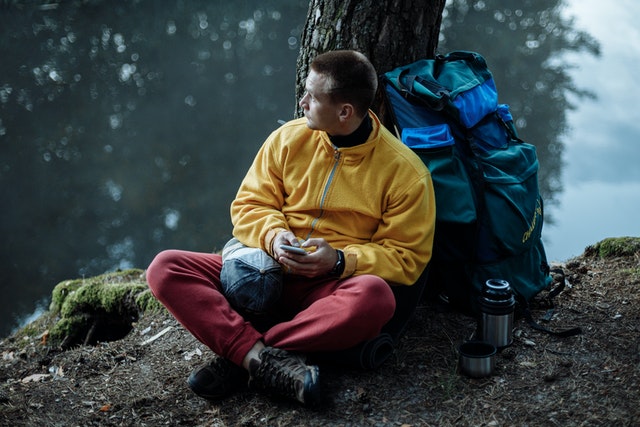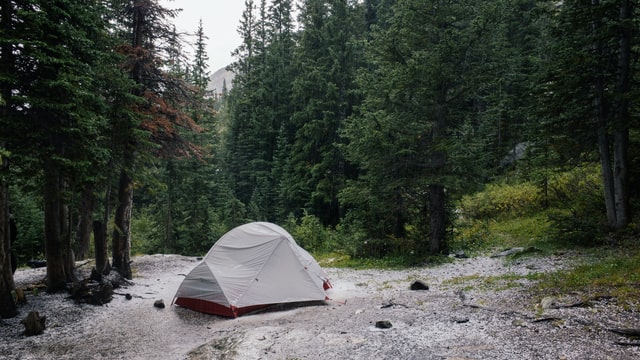
Trying to go camping when it’s raining can be a real pain. But the joy of being outdoors and sleeping under the stars can compensate for any inconvenience. Here are some tips so you can enjoy your rain-soaked camping trip:
PACK A TENT WITH RAINFLY, GROUND SHEET & STAKES
Although tents are waterproof, they don’t have rain flies on them. The groundsheet is waterproof, but the tent itself is not. Stakes are essential for keeping your tent from blowing away in gusty winds, and you’ll want to ensure your tent is breathable, so you don’t sweat yourself into a puddle.
BRING A TARP
- A tarp can be used as a shelter, groundsheet, picnic table, clothesline, rainfly, tent, or hammock.
- Tarp shelters are easy to set up and take down. They don’t require any stakes or ropes to stay in windy weather.
- When setting up camp, you can use your tarp as a groundsheet to protect your space from mud or dirt.
- In addition to being multipurpose and easy-to-use items that double as useful tools for any outdoor excursion (like our favorite backpacking checklist), tarps also come in handy for keeping you dry during rainy days at camp!
PLAN ON GETTING WET (AND PACK ACCORDINGLY)
- Pack rain gear. Any water-resistant outerwear will do, but it’s best to bring a jacket that can also be waterproofed by applying a little bit of wax or spray.
- Bring extra socks, shirts, pants, and underwear; you don’t want your day ruined by one leaky shoe or an unplanned shower!
- Bring extra towels: the ones provided at most campsites will probably not be enough for everyone at your party (or maybe even you). They’re also suitable for drying off after getting wet in the rain—and there’s nothing worse than being cold and wet all day long!
- Wear shoes that can get wet without ruining them—hiking boots work great for this purpose. Remember to pack some extra shoe laces, too; if yours break on the trip, it’s nice to have an extra pair on hand.
SET UP YOUR CAMP IN A DRIER SPOT
When you’re setting up your camp, look for a dry spot. The ground should be relatively level and free of rocks and sticks. The more level, the better for pitching your tent, but if it’s too flat, you’ll have to walk far to find water or firewood. Look for good drainage: if there’s a stream nearby, avoid it because it will flood during rainstorms. Finally, ensure that you’re not pitching your tent directly on top of a lake or river—it may sound obvious, but this happened to me once when I was trying to raise my very first tent in a forest full of pine trees (pine trees grow everywhere). The first storm came along as soon as I finished putting up my tent, and everything flooded with water!
DON’T SKIMP ON SLEEPING GEAR
Your sleeping bag is the essential piece of gear you can have. It’s your insulation from the cold ground, and it will keep you warm when you need to get up in the middle of the night to pee or feed a hungry dog. A quality sleeping bag is rated at least 15 degrees lower than the temperature your campsite will be at during the night—so if there’s a forecast for 30°F, make sure your bag has an EN rating of 15°F or lower.
Some people prefer down bags; others prefer synthetics. Down loads are lighter and pack more minor, but they lose their insulation when wet (unlike synthetic bags). Synthetic bags hold less heat than down ones, but they don’t lose their insulating properties when wet and are much cheaper than down alternatives. If money is no object, choose whichever one feels better on your back!
You also want to ensure that whatever sleeping pad(s) you bring with you is rated for 3 inches or more of cushioning; otherwise, those rocks poking up through my sleeping pad were going straight into my hip joint every time I rolled over in bed! Finally, ensure all your tents are waterproof enough for rainy camping conditions; otherwise, all that money spent on gear will be wasted by getting soaked from condensation dripping off branches overhead (trust me!).
PACK PLENTY OF WARM CLOTHES AND WATERPROOF JACKETS
- Pack plenty of warm clothes and waterproof jackets. Rainy days can be chilly, so it’s essential to pack the right items. If you’re planning on wearing a rain jacket while hiking, ensure it’s comfortable enough to wear over long periods without becoming too hot or constricting.
- Bring your rain gear in an easy-to-carry bag (that way, you’ll have both hands free if there are slippery spots). If your boots get wet during activities like fishing or hiking, try stuffing them with newspaper, so they don’t take up too much room in your backpack.
- Ensure your outdoor gear is stored in a waterproof container or bag(s). You want to keep everything from getting wet so that when it does rain at some point during the trip—which it most likely will—you’ll still have access to all necessary items!
TAKE ELECTRONIC DEVICES ONLY AS A LAST RESORT
We understand that electronic devices can be a lifesaver but can also be a distraction. It would help to decide what is most important and how much effort you want to put into ensuring your devices stay safe and dry.
If you decide to bring electronic devices:
- Take what is necessary (and no more). Leave the power bank at home—you don’t want the extra weight in your bag or pocket. If it’s going to rain, consider taking a waterproof case instead of leaving them out in the open where it could get wet or damaged by sand or dirt.
Being prepared for wet weather is like being prepared for anything when camping.
When you’re camping in the rain, preparation is critical. You want to make sure that your gear is waterproof and be prepared for wet weather conditions if it comes up. Plenty of things can go wrong when camping in the rain: you could get caught in an unexpected downpour, or your tent could leak or get flooded by rainwater.
You should never underestimate the importance of having appropriate gear and supplies on hand when camping—especially when preparing for wet weather conditions like rain! Rainy days don’t have to stop fun experiences outdoors; they require some planning ahead so that everything goes smoothly once those storms roll through (or even worse yet: before they do).
Conclusion
Don’t let a little rain ruin your camping experience! With the right gear, you can keep yourself and your tent dry. We hope our rain camping checklist has given you some ideas on staying dry while still having fun in the great outdoors.
Read more – WHAT IS THE BEST BEST RAIN JACKETS FOR HIKING?
More to explore – Best Camping Supplies
